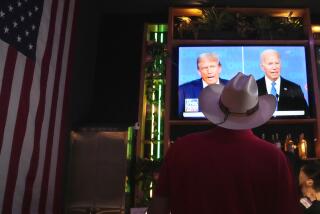Two new camera-shy Supreme Court justices
Without using the term âgoing native,â the New York Times reports that Supreme Court Justices Elena Kagan and Sonia Sotomayor have developed second thoughts about the desirability of televising arguments before the court.
The NYTâs Adam Liptak noted that, at her confirmation hearings, Sotomayor said: âI have had positive experiences with cameras.â But now, echoing her longer-serving colleagues, she worries that televised snippets from arguments would lead viewers who havenât read the briefs (basically, all of them) to think that âthe judge favors this point rather than that point. Very few of them understand what the process is, which is to play devilâs advocate.â
Kagan has executed a similar about-face, Liptak points out: âAt her confirmation hearings in 2010, she said video coverage âwould be a great thing for the institution, and more important, I think it would be a great thing for the American people.â Two years later, she said she now had âa few worries, including that people might play to the cameraâ and that the coverage could be misused.â
I donât think these second thoughts are grounds for impeachment, but they are frustrating for supporters of televising the court (myself included). And they are also rather patronizing.
Most lay people who follow Supreme Court arguments are aware that the justices sometimes play devilâs advocate during oral arguments (and also that they occasionally tip their hand, as Justice Antonin Scalia did during the healthcare arguments when he suggested that the administration was claiming the power to make people buy broccoli). But viewers who didnât understand the Socratic nature of Supreme Court argument could easily be informed about it by a TV reporter. And viewers who wanted the full context could always switch the channel to C-SPAN and watch the argument in its entirety.
Given the comments by Kagan and Sotomayor, it seems unlikely that the justices will be inviting cameras into their courtroom. But they could meet the public and the media halfway by allowing for the same-day release of audio recordings of arguments. Except for rare exceptions -- such as the Obamacare arguments -- those recordings currently arenât made available on the courtâs website until Friday, anywhere from two to four days after the arguments took place. That makes it less likely that a justiceâs comments will be played on the evening news.
My impression of TV coverage of the healthcare arguments is that recordings of the justicesâ comments werenât presented out of context. Not every âsound biteâ is a distortion. Scaliaâs âbroccoliâ line was pithy, but it also encapsulated a serious legal argument about whether the federal government could mandate economic activity.
We get it that the justices arenât ready for their close-up, but why not allow the public to hear their words on the same day theyâre uttered?
ALSO:
Has anyone seen my Google glasses?
The real reason there wonât be women priests
An American capitalist-running-dog vs. the lazy French
More to Read
A cure for the common opinion
Get thought-provoking perspectives with our weekly newsletter.
You may occasionally receive promotional content from the Los Angeles Times.











